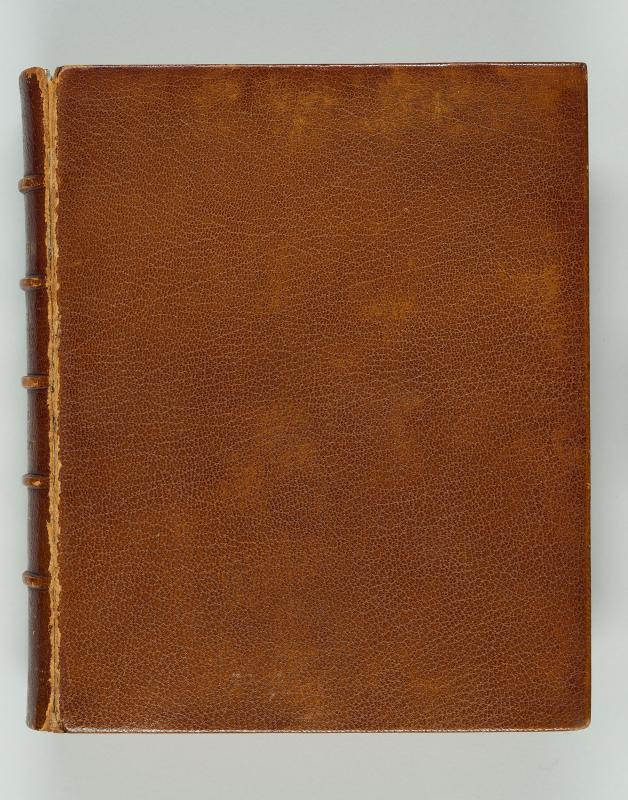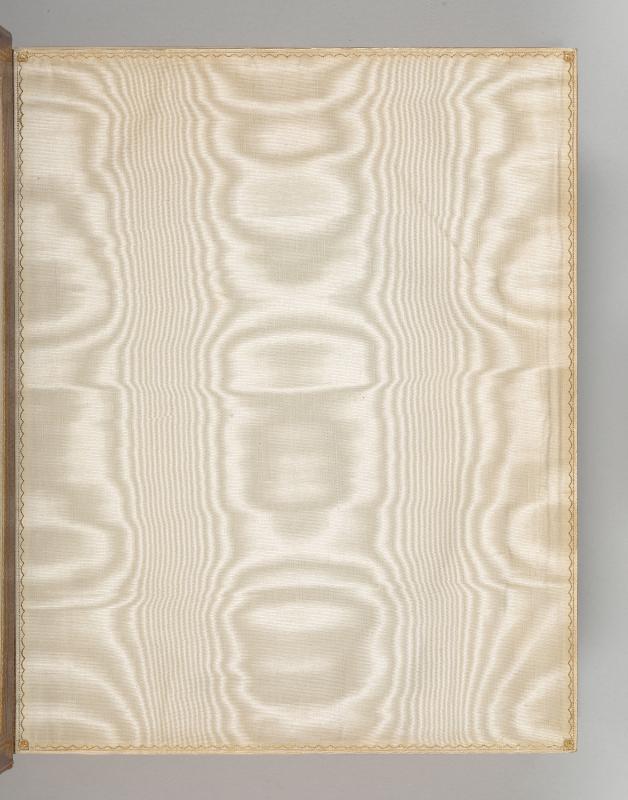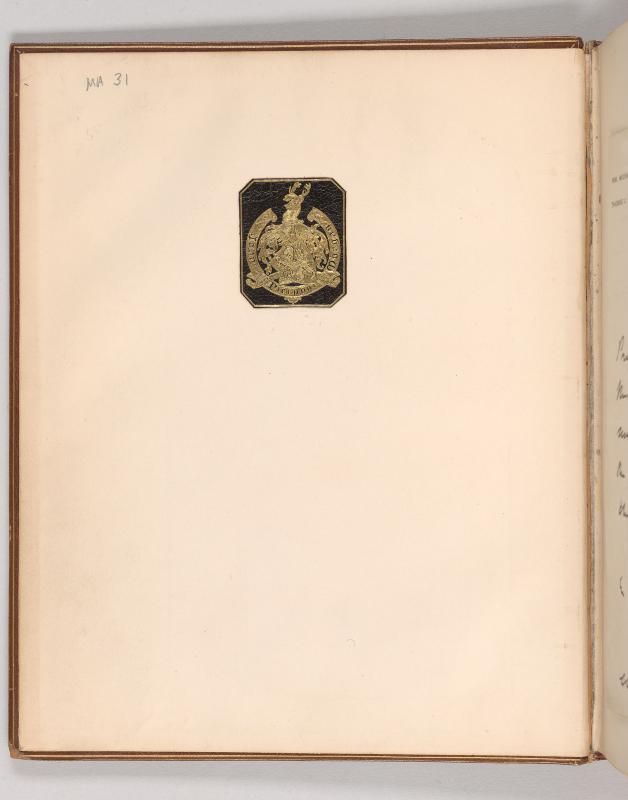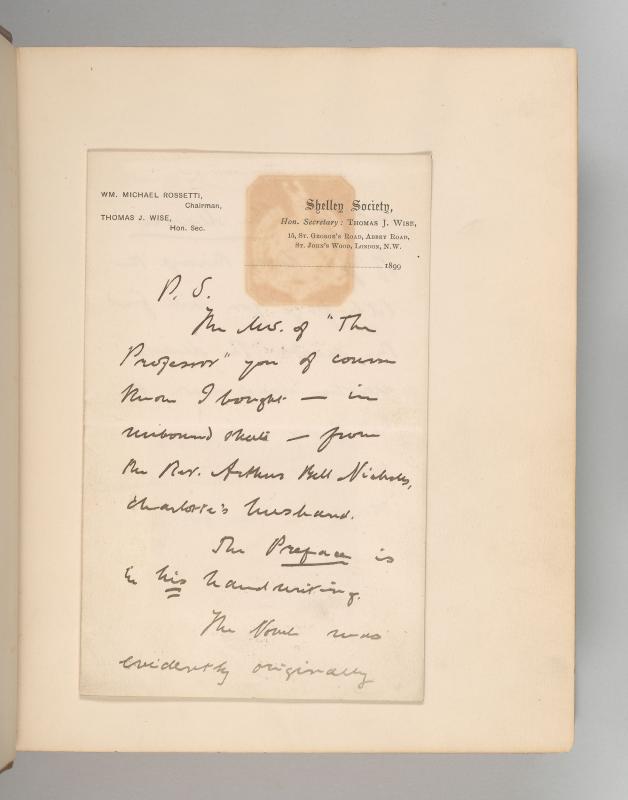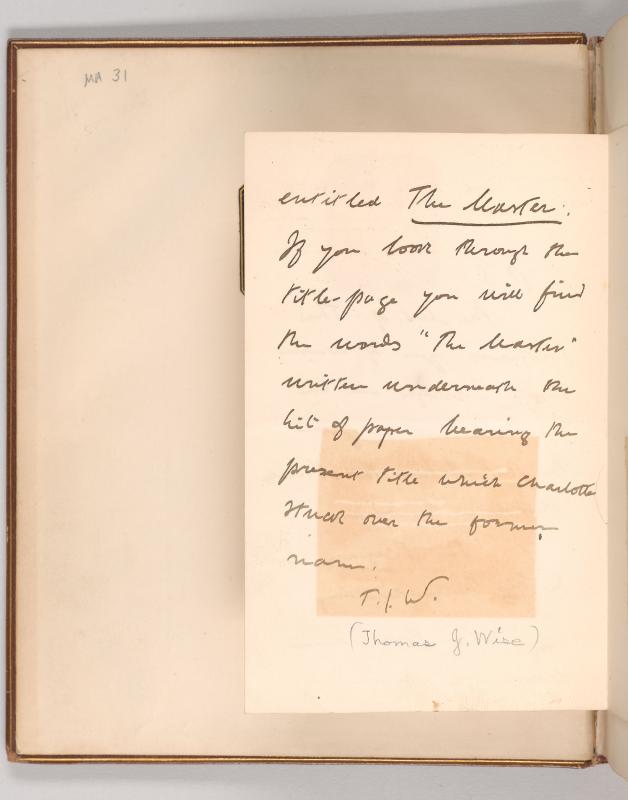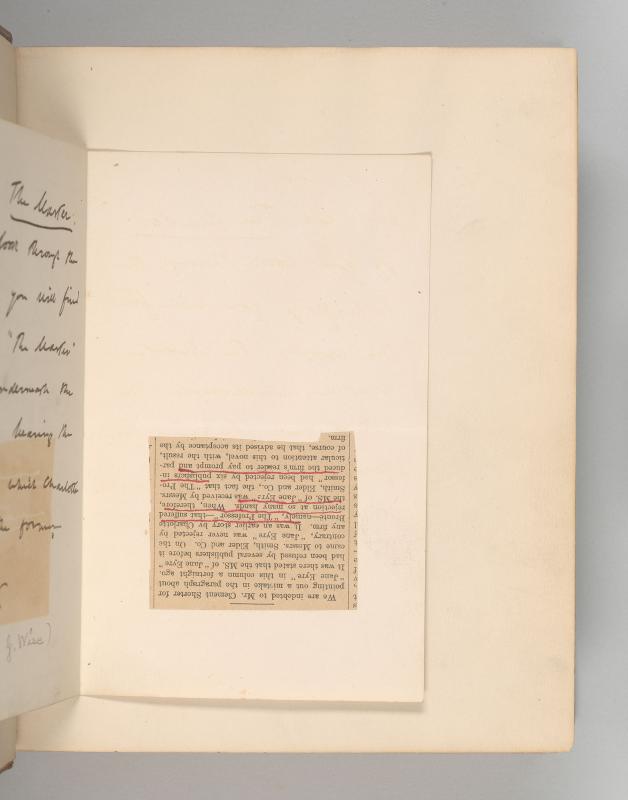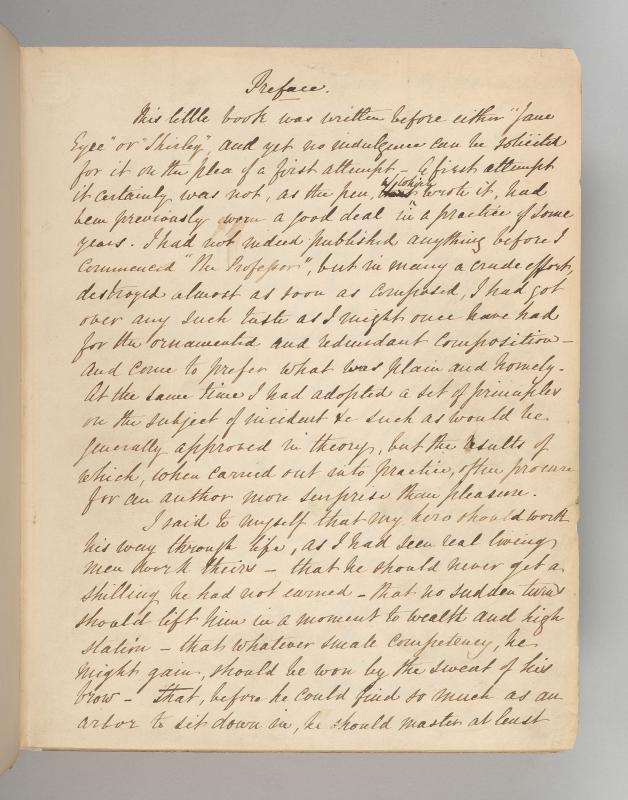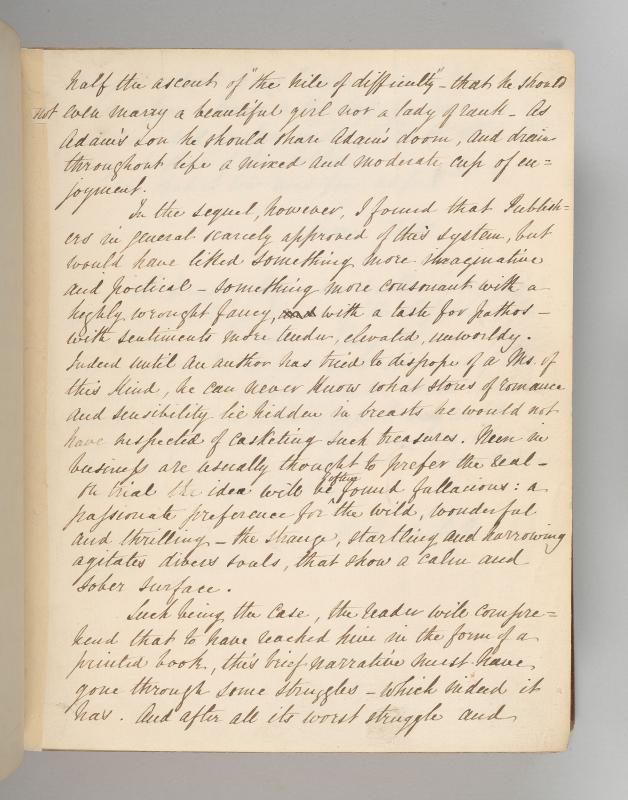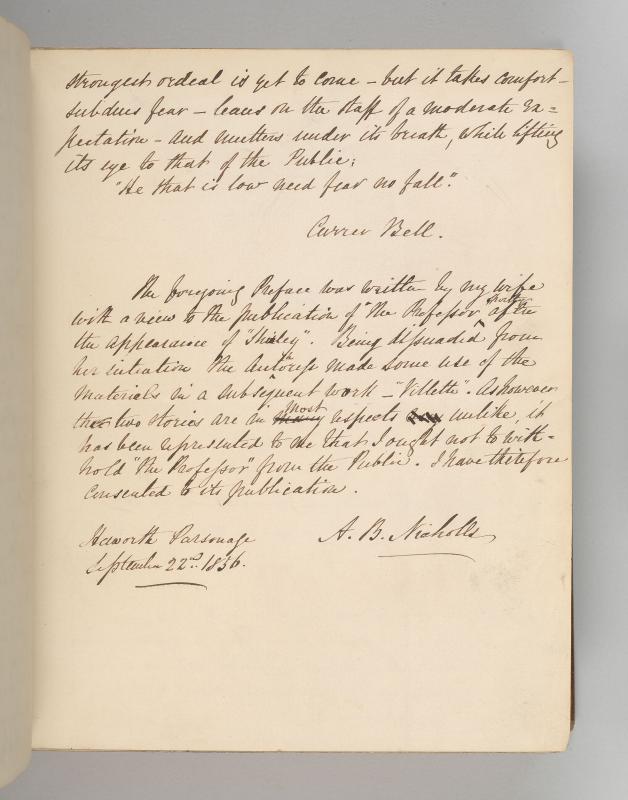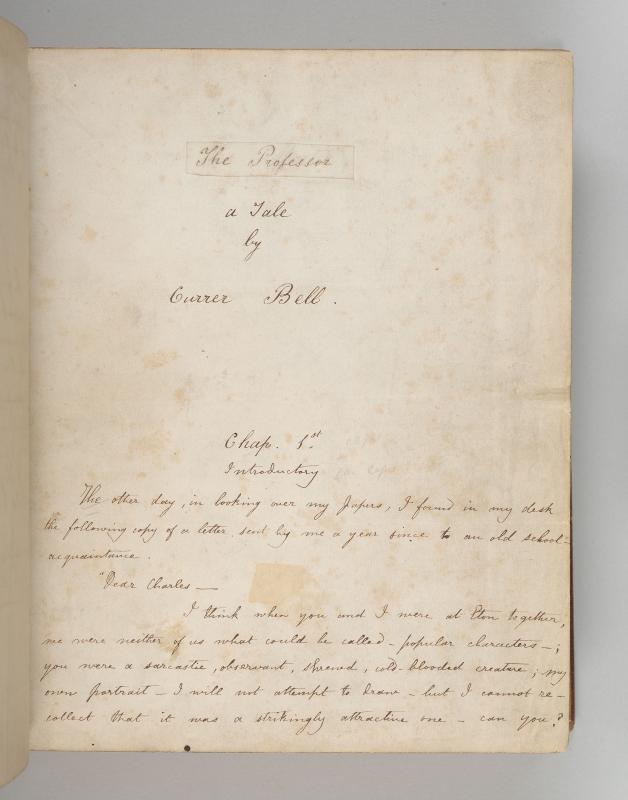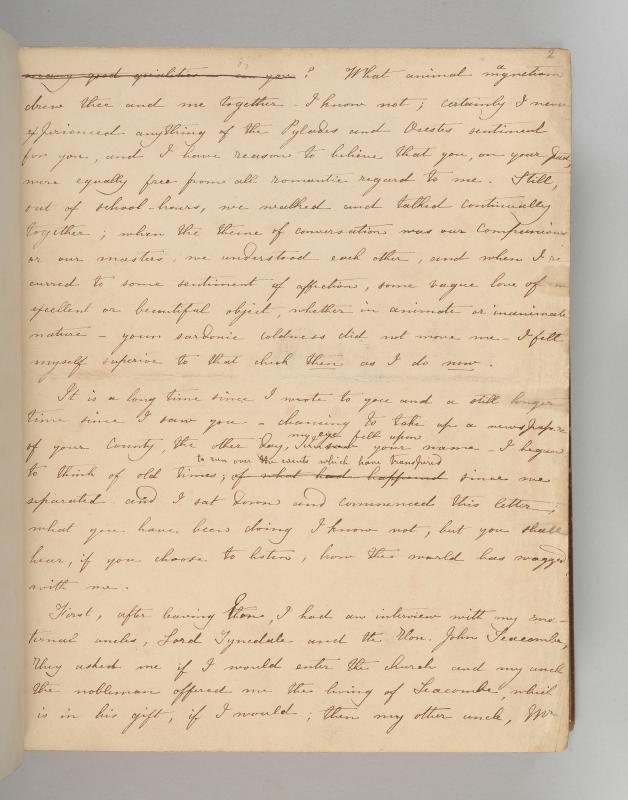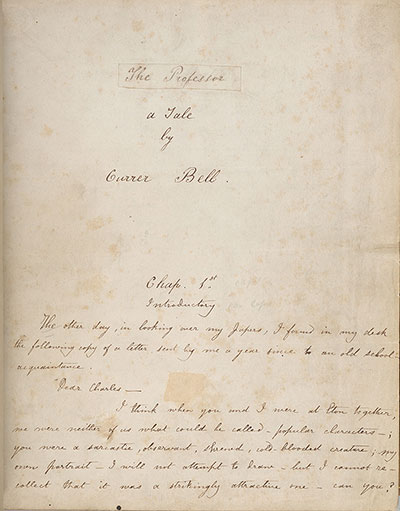
This is the only surviving manuscript of The Professor, the first of four novels by the English author Charlotte Brontë (1816–1855). She likely began drafting the work in 1844 or early 1845, when she was in her late twenties, upon returning home to Haworth after studying abroad in Brussels. By mid-1846, she had prepared this neat, fair copy for submission to prospective publishers. She signed the first page with her pseudonym, Currer Bell, and at some point affixed a small slip of paper with the words The Professor over an earlier draft title, The Master. Brontë wrote in pen and ink on 339 sheets of paper, turning over the final leaf to add the novel’s last few lines, the date of completion—27 June 1846, and the word Finis.
While The Professor was the first novel Brontë completed, it was the last to appear in print. Jane Eyre, Shirley, and Villette were published during Brontë’s lifetime; The Professor did not appear until 1857, two years after the author’s death.
Images of the binding, front matter, and manuscript pages are all presented in this digital facsimile, but blank versos are not included. (Only the versos of folios 5 and 339, on which Brontë wrote, are included.) For researchers who require a complete digital copy of the manuscript including all blank pages, a PDF is provided.
Publication history
In 1846 and 1847, Brontë (using the name Currer Bell) sent this manuscript of The Professor to multiple publishers for consideration. After a relentless stream of refusals, a promising letter arrived from twenty-three-year-old George Smith, who had recently begun to manage his father’s London firm. Smith declined The Professor but made clear he would welcome the chance to consider a three-volume work by the same author, whose true identity he did not yet know.
In fact, even as The Professor manuscript was making its unsuccessful rounds, Brontë had been composing another, longer novel and was ready to send it to Smith shortly after she had read his encouraging words. Smith, Elder & Co. accepted Brontë’s new work—a novel called Jane Eyre—and published it in three volumes in 1847. “Currer Bell” became a literary star, and the Professor manuscript was put aside.
Brontë published a second novel, Shirley, in 1849, after an excruciating year during which her siblings Branwell, Emily, and Anne died in rapid succession. In the wake of so much loss, Brontë found it difficult to create new work and wondered if she might revive the long-forsaken Professor. In 1851, she asked George Smith (who by this time knew Currer Bell’s identity) if he would give the novel another chance. Brontë made further revisions to the text and drafted a preface, alluding to the significant body of writing she had produced (but not published) during her teens and early twenties:
This little book was written before either ‘Jane Eyre’ or ‘Shirley’ and yet no indulgence can be solicited for it on the plea of a first attempt. A first attempt it certainly was not as the pen which wrote it had been previously worn a good deal in a practice of some years.
She went on to explain that she had deliberately turned away from the fanciful compositions of her youth and developed a new theory of “incident,” determined to create a plot free of fantastical coincidences or unbelievable romance: “I said to myself that my hero should work his way through life as I had seen real living men work theirs. . . . that no sudden turns should lift him in a moment to wealth and high station. . . .” But it became clear (as the rejections kept coming) that publishers “would have liked something more imaginative and poetical – something more consonant with a highly wrought fancy. . . .”
Despite Brontë’s efforts to position The Professor as an earnest precursor to Jane Eyre, Smith passed on it yet again. Brontë therefore packed up what she called the “martyrized M.S.” and accepted defeat. When Smith offered to hold onto the stack of handwritten sheets, Brontë responded with humor (or, perhaps, bitterness):
You kindly propose to take ‘the Professor’ into custody. Ah – No! His modest merit shrinks at the thought of going alone and unbefriended to a spirited Publisher. Perhaps with slips of him you might light an occasional cigar - or you might remember to lose him some day - and a Cornhill functionary would gather him up and consign him to the repositories of waste paper. . . . No – I have put him by and locked him up – not indeed in my desk, where I could not tolerate the monotony of his demure quaker countenance, but in a cupboard by himself. (Letter from Brontë to Smith, 5 February 1851).
The demure Professor thus remained alone in his cupboard as Brontë composed what would be her final completed novel, Villette (1853).
After Brontë’s death in 1855, the manuscript of The Professor—which had been mailed, reviewed, refused, resurrected, and returned so many times during the author’s lifetime—finally made its way back to London. Brontë’s widower, Arthur Bell Nicholls, made a few light revisions and added his own brief preface to the one his late wife had drafted several years before, explaining that he had been convinced that he “ought not to withhold ‘The Professor’ from the Public” and that he had “therefore consented to its publication.”
Thus, at long last, the Professor manuscript made its way out of exile and into the printing house. The novel was published in two volumes by Smith, Elder & Co. on 6 June 1857, two years after Brontë’s death and almost eleven years after she had first dispatched the manuscript with high hopes of attaining literary fame.
Provenance
The manuscript of The Professor remained in the custody of Arthur Bell Nicholls, Brontë’s widower, for some four decades before he was approached during the mid-1890s by the author and collector Clement Shorter, who was working on a book about the Brontë authors. Shorter purchased the manuscript on behalf of Thomas J. Wise, a bibliophile and bibliographer later exposed as a forger of printed works.
The London bookseller J. Pearson & Co. obtained the manuscript from Wise and sold it to J. Pierpont Morgan for £350 sometime in the 1890s or early 1900s, though documentation of the precise date of purchase has not been located among the extensive records of Morgan’s interactions with the Pearson firm. The manuscript was certainly in Morgan’s possession by 1908, as his librarian, Belle da Costa Greene, included it in a list of Brontë holdings she sent to F. W. Wheeler of Pearson & Co. that year. Between 1900 and 1911, Morgan made other significant Brontë purchases from Pearson, including literary manuscripts by Charlotte’s sister Anne, devotional books that belonged to various members of the family, and first editions of the Brontë authors’ works.
After the Morgan became a public institution in 1924, its Brontë holdings continued to grow. In the 1960s, Helen Safford Knowles Bonnell made several gifts and a major bequest of manuscripts, letters, drawings, and books that had been acquired by her late husband, the American collector Henry Houston Bonnell, making the Morgan one of the world’s most significant repositories of Brontëana.
The manuscript and binding
The bound manuscript of The Professor is a complex, composite item with traces of at least fourteen people’s markings or physical intervention. Brontë wrote the text on loose sheets of paper, not all uniform. Nicholls, Brontë’s widower, may have made some revisions directly on the manuscript as he prepared it for publication. At the printing house, seven compositors’ names were written in pencil throughout the manuscript to indicate the blocks of text each of them set in type. (See, for example, the name Knapp at the top of f. 14r.)
In the late 1890s or early 1900s, the manuscript was bound by the London firm Zaehnsdorf in gold-tooled brown leather. This work may have been undertaken at the direction of Thomas J. Wise (who had other Brontë manuscripts elaborately bound) or the Pearson firm (which regularly had manuscripts bound for J. Pierpont Morgan). All edges of the text block were trimmed and gilded. While the exterior of the binding was left undecorated, the inner faces of the covers are ornamented with white silk doublures and gold-tooled turn-ins. The binding was signed Bound by Zaehnsdohrf in stamped gilt letters along the bottom edge of the interior front cover. Nicholls’s handwritten transcription of Brontë’s preface was bound in just before the manuscript of the novel. Morgan’s leather bookplate (with motto “Onward and Upward”) was added to the verso of the front flyleaf.
Likely in the late 1910s or 1920s, when Belle da Costa Greene, Morgan’s librarian, began to assign accession numbers to the manuscripts in the collection, she or an assistant wrote M.A. [Manuscript Autograph] 31 on the verso of the first leaf of Nicholls’s manuscript of the preface.
In 1921, as J. Pearson & Co. was preparing to close its business, the firm’s manager, F. W. Wheeler, was going through papers and came across a letter Wise had sent him during the 1890s; Wheeler forwarded the letter to Greene, saying, “As I feel sure you will like to have it I send it, herewith.” Greene had Wise’s letter tipped into the volume that houses the Professor manuscript; only the postscript of the letter is present:
P.S. / The M.S. of “The Professor” you of course know I bought -- in unbound sheets -- from the Rev. Arthur Bell Nicholls, Charlotte’s husband. / The Preface is in his handwriting. / The Novel was evidently originally entitled The Master. If you look through the title-page you will find the words “The Master” written underneath the bit of paper bearing the present title which Charlotte stuck over the former name. / T.J.W.
Below Wise’s initials, Greene wrote his full name (Thomas J. Wise) in pencil. At some point, a newspaper clipping was adhered to the Wise letter; the clipping relates to the publication history of The Professor.
Finally, in about 2003, Morgan curator Christine Nelson added the accession number MA 31 (now rendered without periods, as became the institution’s custom) in pencil on the page with Morgan’s bookplate, as part of a project to standardize the location of tracking information on collection items.
Credits
Introduction by Christine Nelson, Drue Heinz Curator of Literary and Historical Manuscripts, 2021. Provenance research by Leo Gearin, RealArts@Penn intern. Photography by Janny Chiu, 2019. The Morgan acknowledges the scholarship of Margaret Smith and Herbert Rosengarten, editors of the Clarendon edition of The Professor (Oxford University Press, 1987).
The digitization of this manuscript was funded by the Australian Research Council. This digital facsimile serves as a complement to the forthcoming Cambridge Edition of the Novels and Poems of Charlotte, Emily, and Anne Brontë, edited by Christine Alexander (UNSW Sydney) and Tim Dolin (Curtin University, Perth). The Cambridge Edition will include a new edited text of The Professor by Sara L. Pearson, and transcriptions of each page of the manuscript will eventually be added to this digital facsimile.
The facsimile is part of a collaborative project of the Morgan Library & Museum, the British Library, the Brontë Society, and the general editors of the Cambridge Edition to produce online digital images of the manuscripts of Charlotte Brontë’s four novels: The Professor (The Morgan Library & Museum, MA 31), Jane Eyre (The British Library, Add MS 43474, 43475, 43476), Shirley (The British Library, Add MS 43477, 43478, 43479), and Villette (The British Library, Add MS 43480, 43481, 43482).

